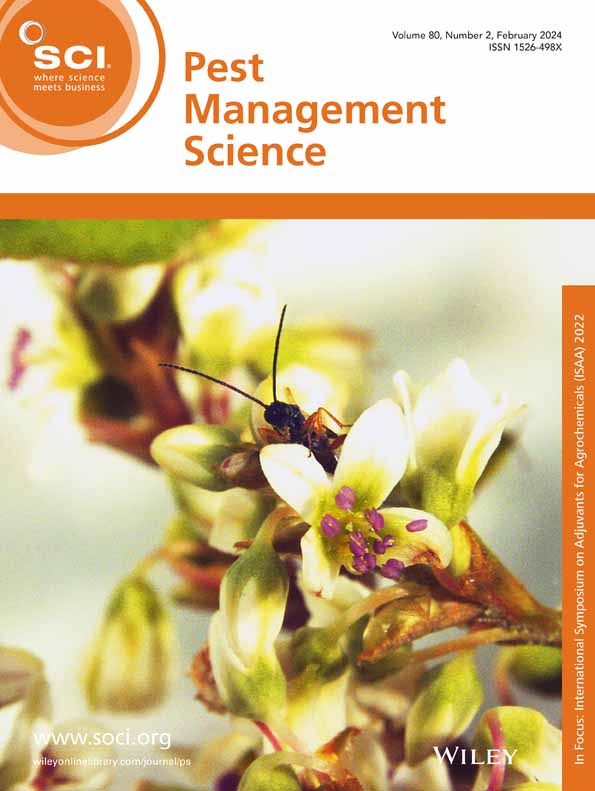Tandem duplication of P450 genes is involved in homoterpene biosynthesis in lima bean (Phaseolus lunatus).
IF 3.8
1区 农林科学
Q1 AGRONOMY
引用次数: 0
Abstract
BACKGROUND The irregular acyclic homoterpenes 4,8-dimethyl-1,3,7-nonatriene (DMNT) and 4,8,12-trimethyl-1,3,7,11-tridecatetraene (TMTT) are key volatile compounds involved in various chemical ecological interactions, particularly contributing to plant defense against phytophagous insects. However, the genomic basis and evolutionary history of homoterpene biosynthesis in legumes remain largely unexplored, limiting our understanding of their functional diversification and ecological roles. RESULTS Using a yeast expression system, we identified two novel, tandemly duplicated cytochrome P450 genes, PlCYP82D47-like and PlCYP82D47, involved in DMNT and TMTT biosynthesis in lima bean (Phaseolus lunatus). PlCYP82D47-like catalyzes the conversion of (E)-nerolidol and (E,E)-geranyllinalool to DMNT and TMTT, respectively, while PlCYP82D47 specifically converts (E)-nerolidol to DMNT. Evolutionary analysis revealed syntenic tandem duplicates of these genes in lima bean, cotton, and Arabidopsis, suggesting a conserved genomic architecture for DMNT/TMTT biosynthesis among dicotyledonous plants and implying potential gene loss events in this genomic region. Computational modeling identified residues L324 and L505 as critical for substrate recognition by PlCYP82D47. Site-directed mutagenesis and in vitro enzymatic assays confirmed that substitutions at these residues significantly reduced catalytic activity. CONCLUSION Our findings provide new insights into the enzymatic and evolutionary basis of homoterpene biosynthesis in legumes and offer promising targets for future metabolic engineering applications. © 2025 Society of Chemical Industry.P450基因的串联复制参与了利马豆(Phaseolus lunatus)的同型萜合成。
不规则的无环同萜类化合物4,8-二甲基-1,3,7-非三苯(DMNT)和4,8,12-三甲基-1,3,7,11-三苯四烯(TMTT)是参与多种化学生态相互作用的关键挥发性化合物,特别是对植物防御植物噬虫有重要作用。然而,豆科植物同源萜类生物合成的基因组基础和进化历史仍未得到充分研究,限制了我们对其功能多样化和生态作用的理解。结果利用酵母表达系统,鉴定了两个新的细胞色素P450基因PlCYP82D47-like和PlCYP82D47,它们参与了利马豆(Phaseolus lunatus) DMNT和TMTT的合成。PlCYP82D47-like分别催化(E)-神经醇和(E,E)-香叶芳樟醇转化为DMNT和TMTT,而PlCYP82D47特异性地将(E)-神经醇转化为DMNT。进化分析显示,这些基因在利马豆、棉花和拟南芥中存在同源串联重复,表明双子叶植物中DMNT/TMTT生物合成存在保守的基因组结构,暗示该基因组区域存在潜在的基因丢失事件。计算模型鉴定出残基L324和L505是PlCYP82D47识别底物的关键。位点定向诱变和体外酶分析证实,这些残基的取代显著降低了催化活性。结论本研究结果为豆科植物同型萜合成的酶学和进化基础提供了新的认识,并为未来代谢工程应用提供了有希望的靶点。©2025化学工业协会。
本文章由计算机程序翻译,如有差异,请以英文原文为准。
求助全文
约1分钟内获得全文
求助全文
来源期刊

Pest Management Science
农林科学-昆虫学
CiteScore
7.90
自引率
9.80%
发文量
553
审稿时长
4.8 months
期刊介绍:
Pest Management Science is the international journal of research and development in crop protection and pest control. Since its launch in 1970, the journal has become the premier forum for papers on the discovery, application, and impact on the environment of products and strategies designed for pest management.
Published for SCI by John Wiley & Sons Ltd.
 求助内容:
求助内容: 应助结果提醒方式:
应助结果提醒方式:


